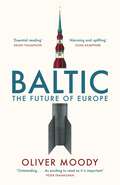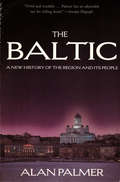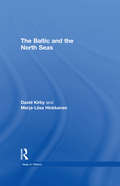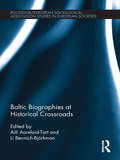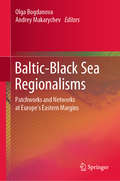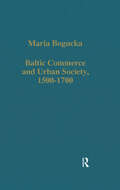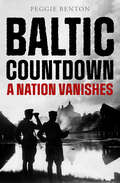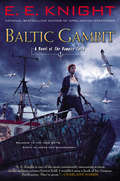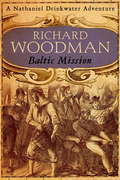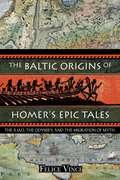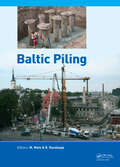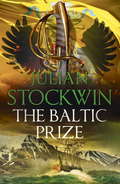- Table View
- List View
Baltic: The Future of Europe
by Oliver MoodyTHE MUST-READ BOOK ON THE WORLD'S BIGGEST FLASHPOINT'Magnificent ... As exciting to read as it is important' Peter Frankopan'Fascinating ... essential reading' Helen Thompson'Alarming and uplifting' John KampfnerThe Baltic will decide the course of the West in the coming years.These nine borderlands are not only the historical battleground of Russian aggression; they are also a factory of ideas for how to revive Europe. Shaped by the past one hundred years, each Baltic country offers lessons in adaptability, hope and prosperity in an era of instability.Innovation in Estonia, patience in Finland, resilience in Poland, even poetry in Latvia: with their tumultuous pasts and exposed geography, these poorly understood frontline states are reconfiguring the balance of power around the heart of Eurasia. From pioneering environmental initiatives and world-leading innovations in technology to ever-growing economies, from tackling disinformation to tempering the populist right, the Baltic states are now key to understanding how political events might unfold in the coming years.Blending history, politics and reportage, this is the first book to explain why these are some of our most imaginative allies, yet most of us know so little about them. Interviewing prime ministers, presidents, generals, intelligence officers, business leaders and ordinary people, Oliver Moody traces the extraordinary emergence of a new fulcrum of great-power rivalry. But the real reason we need to understand them is that their fate is ours.
Baltic: The Future of Europe
by Oliver MoodyTHE MUST-READ BOOK ON THE WORLD'S BIGGEST FLASHPOINT'Magnificent ... As exciting to read as it is important' Peter Frankopan'Fascinating ... essential reading' Helen Thompson'Alarming and uplifting' John KampfnerThe Baltic will decide the course of the West in the coming years.These nine borderlands are not only the historical battleground of Russian aggression; they are also a factory of ideas for how to revive Europe. Shaped by the past one hundred years, each Baltic country offers lessons in adaptability, hope and prosperity in an era of instability.Innovation in Estonia, patience in Finland, resilience in Poland, even poetry in Latvia: with their tumultuous pasts and exposed geography, these poorly understood frontline states are reconfiguring the balance of power around the heart of Eurasia. From pioneering environmental initiatives and world-leading innovations in technology to ever-growing economies, from tackling disinformation to tempering the populist right, the Baltic states are now key to understanding how political events might unfold in the coming years.Blending history, politics and reportage, this is the first book to explain why these are some of our most imaginative allies, yet most of us know so little about them. Interviewing prime ministers, presidents, generals, intelligence officers, business leaders and ordinary people, Oliver Moody traces the extraordinary emergence of a new fulcrum of great-power rivalry. But the real reason we need to understand them is that their fate is ours.
The Baltic
by Michael NorthFrom the Vikings to the EU the Baltic has been a Nordic Mediterranean, a shared maritime zone with distinct patterns of trade, cultural exchange, and conflict. Covering a thousand years in a part of the globe where seas are more connective than land, Michael North's overview transforms the way we think about one of the world's great waterways.
The Baltic
by Alan PalmerIn this long-needed history of the peoples and nations surrounding the Baltic Sea, we pass through the legendary castles of Elsinore and Halsingborg to enter a unique landscape and culture. Alan Palmer traces the history of the Baltic region from its early Viking days and its time under the Byzantine Empire through its medieval prime when the Baltic Sea served as one of Europe’s central trading grounds. Palmer addresses both the strong nationalist sentiments that have driven Baltic culture and the early attempts at Baltic unification by Sweden and Russia. The Baltic also dissects the politics and culture of the region in the twentieth century, when it played multiple historic roles: it was the Eastern Front in the First World War; the setting of early uprisings in the Russian Revolution; a land occupied by the Nazis during the Second World War; and, until very recently, a region dominated by the Soviets. In the twenty-first century, increasing attention has been focused on the Baltic states as they grow into their own in spite of growing neo-imperialist pressure from post-Soviet Russia. In The Baltic, Alan Palmer provides readers with a detailed history of the nations and peoples that are now poised to emerge as some of Europe’s most vital democracies.
Baltic
by Alan PalmerIn this long-needed history of the peoples and nations surrounding the Baltic Sea, we pass through the legendary castles of Elsinore and Halsingborg to enter a unique landscape and culture. Alan Palmer traces the history of the Baltic region from its early Viking days and its time under the Byzantine Empire through its medieval prime when the Baltic Sea served as one of Europe's central trading grounds. Palmer addresses both the strong nationalist sentiments that have driven Baltic culture and the early attempts at Baltic unification by Sweden and Russia. The Baltic also dissects the politics and culture of the region in the twentieth century, when it played multiple historic roles: it was the Eastern Front in the First World War; the setting of early uprisings in the Russian Revolution; a land occupied by the Nazis during the Second World War; and, until very recently, a region dominated by the Soviets. In the twenty-first century, increasing attention has been focused on the Baltic states as they grow into their own in spite of growing neo-imperialist pressure from post-Soviet Russia. In The Baltic Alan Palmer provides readers with a detailed history of the nations and peoples that are now poised to emerge as some of Europe's most vital democracies.
The Baltic
by Alan PalmerIn this long-needed history of the peoples and nations surrounding the Baltic Sea, we pass through the legendary castles of Elsinore and Halsingborg to enter a unique landscape and culture. Alan Palmer traces the history of the Baltic region from its early Viking days and its time under the Byzantine Empire through its medieval prime when the Baltic Sea served as one of Europe's central trading grounds. Palmer addresses both the strong nationalist sentiments that have driven Baltic culture and the early attempts at Baltic unification by Sweden and Russia. The Baltic also dissects the politics and culture of the region in the twentieth century, when it played multiple historic roles: it was the Eastern Front in the First World War; the setting of early uprisings in the Russian Revolution; a land occupied by the Nazis during the Second World War; and, until very recently, a region dominated by the Soviets. In the twenty-first century, increasing attention has been focused on the Baltic states as they grow into their own in spite of growing neo-imperialist pressure from post-Soviet Russia. In The Baltic, Alan Palmer provides readers with a detailed history of the nations and peoples that are now poised to emerge as some of Europe's most vital democracies.
The Baltic and the North Seas (Seas in History)
by Merja-Liisa Hinkkanen David KirbyExploring the themes of the human relationship with the marine environment and the ways in which the peoples of Northern Europe have experienced and exploited their seas, this book reveals how human perception of the northern seas has changed over time.Drawing on a wide variety of sources, from Denmark and Britain to Norway, Finland and Germany, The Baltic and the North Seas is an insightful and colourful history of the politics, economy and culture of this intriguing region.
Baltic Beverages Holding: Competing in a Globalizing World (A)
by Rakeen Mabud Rasmus Molander Juan AlcacerThe Finnish brewer Hartwall and the Swedish brewer Pripps had to decide how to react to the rapidly changing European political, economic, and business environment in 1989-1990.
Baltic Beverages Holding: Competing in a Globalizing World (B)
by Rakeen Mabud Rasmus Molander Juan AlcacerIn 1991, Hartwall and Pripps made the decision to found Baltic Beverages Holding (BBH) and invest in the former USSR by buying Estonia's biggest brewery, Saku.
Baltic Beverages Holding: Competing in a Globalizing World (A)
by Juan Alcacer Rakeen Mabud Rasmus MolanderThe Finnish brewer Hartwall and the Swedish brewer Pripps had to decide how to react to the rapidly changing European political, economic, and business environment in 1989-1990.
Baltic Biographies at Historical Crossroads (Studies in European Sociology)
by Aili Aarelaid-Tart and Li Bennich-BjörkmanThis book brings together life stories from five generations of Balts, living through the diverse and recurring transformations of the twentieth century: occupations, war, independence, totalitarianism, and democratic rule and market economy. The twentieth century history of the Baltic countries has often been deeply tragic. Lying on the coastline of the Baltic Sea, these rather small but strategically well located territories have historically found themselves in the middle of many power struggles between larger states, empires and other power-holders: the Teutonic Knights, Swedish kings, Tsarist Russia, Nazi Germany, the Soviet Union. Today, they are once again forced to stand up to the Russian Federation. Biographical interviewing is a field focused on individuals, and on how those individuals choose to re-create and present their lived lives, make meaning of it through the narratives they tell. To interpret the biographical narrations of Lithuanians, Latvians and Estonians, shaped by complex and controversial historical background, the authors use Pierre Bourdieu’s concept of social and cultural capitals, the principles of Erving Goffman’s framing analysis and Alessandro Portelli’s distinction of private and public spheres, Anton Steen’s investigations of post-Socialist elites and Piotr Sztompka’s theory of cultural trauma, etc. Given analyses of particular biographical narrations are supplemented by brief historical and sociological overviews, which allow the reader to better understand the contexts of lived lives, and the mental atmosphere in which the interviews were conducted.
Baltic-Black Sea Regionalisms: Patchworks and Networks at Europe's Eastern Margins
by Olga Bogdanova Andrey MakarychevThis edited volume focuses on various forms of regionalism and neighborhoods in the Baltic-Black Sea area. In the light of current reshaping of borderlands and new geopolitical and military confrontations in Europe’s eastern margins, such as the annexation of Crimea and the war in Donbas, this book analyzes different types and modalities of regional integration and region-making from a comparative perspective. It conceptualizes cooperative and conflictual encounters as a series of networks and patchworks that differently link and relate major actors to each other and thus shape these interconnections as domains of inclusion and exclusion, bordering and debordering, securitization and desecuritization. This peculiar combination of geopolitics, ethnopolitics and biopolitics makes the Baltic-Black Sea trans-national region a source of inspiring policy practices, and, in the light of new security risks, a matter of increased concern all over Europe. The contributors from various disciplines cover topics such as cultural and civilizational spaces of belonging and identity politics, the rise of right-wing populism, region building under the condition of multiple security pressures, and the influence and regional strategies of different external powers, including the EU, Russia, and Turkey, on cross- and trans-regional relations in the area.
Baltic Commerce and Urban Society, 1500-1700: Gdansk/Danzig and its Polish Context (Variorum Collected Studies)
by Maria BoguckaThe great merchant port of Danzig, now Gdansk, is at the centre of this set of studies by Professor Maria Bogucka. Through it passed the greatest part of the trade that linked the West with Poland and the Baltic; from it the commercial culture of the West spread out into the towns of Poland, and with it new currents in religion and urban life, and from there it began to permeate the whole of Polish society. The studies in this volume examine both the social and economic sides of this process, looking at articles of commerce and trends in urbanization, as well as patterns of poor relief and gender relations. The author's aim is to analyse specific aspects of what happened in Poland, while situating these in the broader context of the development of early modern European society.
Baltic Countdown: A Nation Vanishes
by Peggie BentonA firsthand account of Latvia during World War II: &“A British diplomat&’s wife&’s beautifully observed eye-witness account of the Soviet occupation.&” —Condé Nast Traveler With her husband in the British Foreign Service, Peggie Benton had already lived through the Nazi invasion of Austria in 1938 and had settled comfortably into the day-to-day life of Riga, the capital of Latvia. But the country&’s uneasy history with Russia and tensions brewing with Germany just prior to the outbreak of World War II meant their peace was not to last. In this compelling memoir, Benton captures both the small details of life in the city—the markets, the winter customs, the Baltic character—and the terrifying moments during the evacuation of Baltic Germans and the Soviet invasion that left the couple homeless and with an uncertain fate. Their world comes crashing down during the chaos of war, and the Bentons are forced to flee more than twenty-two thousand miles eastward across Russia on the Trans-Siberian Railway to Japan, then through Canada to England, crossing both the Pacific and Atlantic Oceans.Baltic Countdown is a tribute to the people of Latvia, Lithuania, and Estonia—their resilience through the trials of history and their never-ending hope of independence. &“An engaging account in its own right . . . A bittersweet memoir of a city on the edge of disaster. Her compelling depiction of Riga and its inhabitants conjures up a world that is almost unknown in the West.&” —Studies in Intelligence, CIA journal
The Baltic Countries
by Julian Berengaut Augusto Lopez-Claros Françoise Le Gall Dennis Jones Richard Stern Ann-Margret Westin Effie Psalida Pietro GaribaldiAre the three Baltic countries, Latvia, Estonia, and Lithuania, ready for accession to the European Union? Have their economies overcome the problems of transition? the answers to these questions and their implications for policy are provided in this collection of analyses. Rather than a country-by-country description, the volume provides a cross-country perspective of developments from 1994 through mid-1997. the seven sections of this paper discuss recent macroeconomic and structural policies, exchange rate regimes, fiscal issues, financial systems, private sector development, and accession to the European Union.
The Baltic Countries: Medium-Term Fiscal Issues Related to EU and NATO Accession
by International Monetary FundTen years after regaining independence, the three Baltic countries of Estonia, Latvia, and Lithuania are now fully functioning market economies. They are on the verge of acceding to the European Union (EU) and the North Atlantic Treaty Organisation (NATO), and this paper discusses the fiscal challenges they face in the run-up to the accession process.
Baltic Crustaceans
by Anna SzaniawskaThis book presents all Malacostracan cructaceans occurring in the Baltic Sea in water salinity from 2 to 15 psu. The Baltic sea is very special due to its low salinity and characteristic fauna. For each of the 58 species the systematic position, the origin and distribution in European waters are given, and the environmental preferences, the role in the food web and human economy described. The book describes the history of the Baltic sea and the occurrence of crustaceans in its history against the terms of hydrological conditions, explaining why in the Baltic sea only part of all marine crustaceans occur. The book is richly illustrated with photographs and beautiful pictures of animals specifically prepared for this book.
Baltic Gambit
by E. E. KnightIn his latest Vampire Earth novel, national bestselling author E. E. Knight delivers a thrilling adventure when David Valentine's loyal Lieutenant Alessa Duvalier disobeys his orders#151;and finds herself uncovering a betrayal#133; While out scouting in southern Indiana, Alessa Duvalier comes across a Kurian Conference being attended by every major military sect the Kurians have in the Midwest. Taking advantage of the strategic opportunity to cripple their enemy, Alessa and her warriors strike and achieve victory#151;only to discover an even greater threat to humanity. Most of the world's resistance leaders and the Lifeweavers are gathering for a peace conference in Helsinki, Finland, and according to the intelligence materials Alessa recovered during her raid, the Kurians have already inserted an agent among the delegates. David Valentine is chosen to be head of security for the Army of Kentucky representatives#151;and Alessa ignores his order to stay behind. Now, thrust into a lethal intrigue that threatens the entire peace process, she learns that the Kurian agent may be the least of her concerns. For the Lifeweavers themselves are about to reveal something that will devastate the Resistance
Baltic Hospitality from the Middle Ages to the Twentieth Century: Receiving Strangers in Northeastern Europe (Palgrave Studies in Migration History)
by Christina Reimann Wojtek Jezierski Sari Nauman Leif RunefeltReflecting debate around hospitality and the Baltic Sea region, this open access book taps into wider discussions about reception, securitization and xenophobic attitudes towards migrants and strangers. Focusing on coastal and urban areas, the collection presents an overview of the responses of host communities to guests and strangers in the countries surrounding the Baltic Sea, from the early eleventh century to the twentieth. The chapters investigate why and how diverse categories of strangers including migrants, war refugees, prisoners of war, merchants, missionaries and vagrants, were portrayed as threats to local populations or as objects of their charity, shedding light on the current predicament facing many European countries. Emphasizing the Baltic Sea region as a uniquely multi-layered space of intercultural encounter and conflict, this book demonstrates the significance of Northeastern Europe to migration history.
Baltic Mission: Number 7 in series (Nathaniel Drinkwater #7)
by Richard WoodmanCaptain Nathaniel Drinkwater's frigate, HMS Antigone, is ordered to the Baltic Sea in the spring of 1807 as Napoleon's grip has begun to reach across Europe to the borders of Holy Russia. As country after country falls under the weight of French domination, Captain Drinkwater is faced with the challenges brought about by military disaster and diplomatic intrigue. On board the Antigone, Drinkwater is threatened by the seething discontent of his crew and the instability of his drunken first lieutenant. Drinkwater's task is to cooperate with his country's allies and intelligence agents. When a coded message is intercepted, his mission suddenly becomes one of extreme personal danger. As the fate of Europe is being decided, Drinkwater must carry out his mission in the face of his old enemy. This final confrontation brings him to the brink of death.
The Baltic Nations and Europe: Estonia, Latvia and Lithuania in the Twentieth Century
by John Hiden Patrick SalmonOf all the Soviet Union's subject nationalities, the three Baltic republics, Estonia, Latvia and Lithuania, were the most determined and best organised in seizing the opportunities created by glasnost and perestroika to win freedom from Moscow's grip.At the time of first publication, in 1991, the final section of the book was speculative. Now for this revised edition, the authors have provided a new final chapter which brings the story up to date -- and the three republics to political independence again.
The Baltic Origins of Homer's Epic Tales: The Iliad, the Odyssey, and the Migration of Myth
by Felice VinciCompelling evidence that the events of Homer's Iliad and Odyssey took place in the Baltic and not the Mediterranean• Reveals how a climate change forced the migration of a people and their myth to ancient Greece • Identifies the true geographic sites of Troy and Ithaca in the Baltic Sea and Calypso's Isle in the North Atlantic OceanFor years scholars have debated the incongruities in Homer's Iliad and Odyssey, given that his descriptions are at odds with the geography of the areas he purportedly describes. Inspired by Plutarch's remark that Calypso's Isle was only five days sailing from Britain, Felice Vinci convincingly argues that Homer's epic tales originated not in the Mediterranean, but in the northern Baltic Sea. Using meticulous geographical analysis, Vinci shows that many Homeric places, such as Troy and Ithaca, can still be identified in the geographic landscape of the Baltic. He explains how the dense, foggy weather described by Ulysses befits northern not Mediterranean climes, and how battles lasting through the night would easily have been possible in the long days of the Baltic summer. Vinci's meteorological analysis reveals how a decline of the "climatic optimum" caused the blond seafarers to migrate south to warmer climates, where they rebuilt their original world in the Mediterranean. Through many generations the memory of the heroic age and the feats performed by their ancestors in their lost homeland was preserved and handed down to the following ages, only later to be codified by Homer in the Iliad and the Odyssey.Felice Vinci offers a key to open many doors that allow us to consider the age-old question of the Indo-European diaspora and the origin of the Greek civilization from a new perspective.
Baltic Piling
by M. Mets R. Raudsepp'Baltic Piling' contains the proceedings of theBaltic Piling Days 2012 (Tallinn, Estonia, 3-5 September 2012). The book includes contributions on current issues in pile foundation engineering:- Interaction of pile and grillage;- Formation of pile bearing capacity- Settlements of piles- Pile foundation under historical buildings- Thermopiles, and
The Baltic Prize: Thomas Kydd 19
by Julian Stockwin1808. Parted from his new bride, Captain Sir Thomas Kydd is called away to join the Northern Expedition to Sweden, now Britain's only ally in the Baltic. Following the sudden declaration of war by Russia and with the consequent threat of the czar's great fleet in St Petersburg, the expedition must defend Britain's dearly-won freedom in those waters. However Kydd finds his popular fame as a frigate captain is a poisoned chalice; in the face of jealousy and envy from his fellow captains, the distrust of the commander-in-chief and the betrayal of friendship by a former brother-in-arms now made his subordinate, can he redeem his reputation?In an entirely hostile sea Tyger ranges from the frozen north to the deadly confines of the Danish Sound - and plays a pivotal role in the situation ensuing after the czar's sudden attack on Finland. This climaxes in the first clash of fleets between Great Britain and Russia in history. To the victor will be the prize of the Baltic!******************PRAISE FOR JULIAN STOCKWIN'S THOMAS KYDD SERIES'Paints a vivid picture of life aboard the mighty ship-of-the-line' Daily Express'This heady adventure blends fact and fiction in rich, authoritative detail' Nautical Magazine on VICTORY'Fans of fast-paced adventure will get their fill with this book' Historical Naval Society on THE ADMIRAL'S DAUGHTER
The Baltic Prize: Thomas Kydd 19 (Thomas Kydd #19)
by Julian Stockwin1808. Parted from his new bride, Captain Sir Thomas Kydd is called away to join the Northern Expedition to Sweden, now Britain's only ally in the Baltic. Following the sudden declaration of war by Russia and with the consequent threat of the czar's great fleet in St Petersburg, the expedition must defend Britain's dearly-won freedom in those waters. However Kydd finds his popular fame as a frigate captain is a poisoned chalice; in the face of jealousy and envy from his fellow captains, the distrust of the commander-in-chief and the betrayal of friendship by a former brother-in-arms now made his subordinate, can he redeem his reputation?In an entirely hostile sea Tyger ranges from the frozen north to the deadly confines of the Danish Sound - and plays a pivotal role in the situation ensuing after the czar's sudden attack on Finland. This climaxes in the first clash of fleets between Great Britain and Russia in history. To the victor will be the prize of the Baltic!******************PRAISE FOR JULIAN STOCKWIN'S THOMAS KYDD SERIES'Paints a vivid picture of life aboard the mighty ship-of-the-line' Daily Express'This heady adventure blends fact and fiction in rich, authoritative detail' Nautical Magazine on VICTORY'Fans of fast-paced adventure will get their fill with this book' Historical Naval Society on THE ADMIRAL'S DAUGHTER
